 |
 18th April 1999 |
Front Page| |
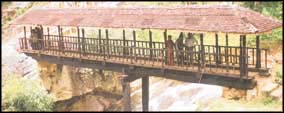 Bridge acorss the centuries |
Contents
|
|
 |
Lester James Peries: An 80th birthday tributeWork of a poetBy Richard BoyleIn early 1973, having heard I was soon to fly out to Sri Lanka to work on the epic film project, The God King, I began to scour London for information about the director, Lester James Peries. Although I had seen the highly acclaimed Nidhanaya at the London Film Festival just weeks before, Lester was still relatively unknown in England. One of my first stops, I clearly remember, was the riverside bar of the National Film Theatre, where I intercepted and interrogated the film critic John Gillett, who I knew was knowledgeable on the subject. Another stop was at the Soho offices of Charlie Cooper's Contemporary Films. This extraordinary man, supporter of independent film makers worldwide, was Lester's European distributor. My last stop was to visit a friend working at the National Film Archives so that I might obtain copies of photographs of scenes from Lester's films. That's how I ended up with a portfolio of stills from his early films, encompassing the period that started with Rekava (1956) and ended with Nidhanaya (1971 ). Some of these stills are featured here as an 80th birthday tribute to Lester. I make no apologies for the fact that my tribute to Lester covers only his initial period as a film director, for it turned out to be a clearly delineated one in Lester's career. It was a period that ended with the temporary international distractions of The God King, and gave way afterwards to yet another phase in his long and distinguished career. As it happens, this is more or less the pe riod covered in Philip Coorey's The Lonely Artist: A Critical Introduction to the films of Lester James Peries ( Colombo: 1970). It seemed appropriate, therefore, to extract parts of the text of this and other film writings and reviews of the period to accompany the stills. I shall end by quoting the challenging words of the programme notes of a Lester James Peries retrospective, held at the National Film Theatre in 1982: "Trust us. Trust our enthusiasms. These exotic experiences will not harm you. On the contrary you will find them uplifting, compassionate and never, ever, boring. There is nothing dusty or obscure about these movies. They are the work of a poet, characterised by strong narratives told in intriguing locales. They share a concern for the human spirit." Rekava (The Line Of Destiny) 1956
***************** "Lester James Peries' first feature film, Rekava, immediately established his international reputation; it was a financial flop in the country of its origin, but marked the first truly artistic achievement by any Sinhala film. It was also the first "Sinhala" film by any standards. It drove Lester into the cinematic wilderness for four years - and yet it was commercially distributed in English, Russian, Czech, French and German. It contains, in microcosm, in its themes, attitudes, camera-work, location shots, editing, use of song and music, all that Lester was to develop in his later films. "Lester, his cameraman Willie Blake and his editor Titus Thotawatte staked their careers on the film. Although the mass audience roundly rebuffed it, they received the acclaim of discerning men and women, who were sick of the artificiality of the so-called Sinhala films that had been foisted on the public up to the time of Rekava. Lester himself relates the story of how he stayed, unnoticed, outside a large cinema in Colombo when the film was in its opening week, and listened to the comments of the crowd. The general opinion seemed to be that the film-goers would have better spent their money feeding the crows outside the cinema than wasting it on such trash as Rekawa. "When the film was originally released in Ceylon, a critic wrote that the artificial barriers built by the industry between the real life of the people and the screen, had been torn down by Lester James Peries. This is true; but the tragedy was that the people did not want to see themselves realistically. The fantasy was so much more pleasant. It was mainly due to the efforts of Lester that within a decade, audiences had adopted a new approach to the cinema, in the sense that they were able to appreciate films that did not contain a formula." - Philip Coorey Sandesaya (The Message) 1960
* * * * * * * * * * "It all began in the early weeks of 1958 when my colleague Willie Blake and I discussed the possibility of making a film based on the Portuguese occupation of Ceylon. Here we decided, was a veritable storehouse of themes, stories and characters with immense potentialities for real cinema. There were patriots and traitors, guerrilla fighters of immense resources and cunning pitting themselves against European military strategists. There were spies and flatterers, sadists and turncoats on both sides. There was drama not only in the cellars of the great walauwes and within the stone walls of the Portuguese garrisons, but also in the mountain ranges and forests of the Kandyan hills. "In working out our story we knew what we did not want to do. We wished to eschew spectacle, the staging of large-scale battle scenes and the use of opulent costumes and settings. Our predilection was to shoot our story out-of-doors instead of following the usual practice of shooting in the studios against hideously painted backdrops which caricatured the loveliness of our island scene. We had neither the inclination nor the technical resources to produce a Hollywood style epic. "On the other hand, we were determined to exploit to the full those elements in our story which were within our resources. We could concentrate on character and atmosphere; we could use action naturally to push our narrative forward and most important of all, we could use the breath-taking beauty of our mountains and hills not merely as a 'pretty-pretty' backdrop but as an integral part of our drama." - Lester James Peries Ran Salu (The Yellow Robe) 1967
************** "With Ran Salu, Lester James Peries presented directly a theme which he had touched on briefly at the end of Sandesaya. He also for the first time consented to direct a film based on a story and screenplay over which he had no control. The result, visually, was pure Lester in parts; but the moral parable he consented to film did not give him enough scope to concentrate on the personal relationships that usually fascinate him. The script had a very strong Buddhist theme, emphasizing the peace found in Buddhist meditation, and the withdrawal from worldly materialistic pleasures. Lester, as a Catholic, obviously felt that even in his directorial role, he should not tamper with the script-writer's conception of the plot, as well as the main theme. He thus set out only to translate this, as best as he could, visually. The photography is by Sumitta Amarasinghe - the first time that Lester worked without Willie Blake. There is another difference; indoor shooting is dominant. . .Ran Salu is away from the mainstream of Lester's work in the cinema. Not so far away as Sandesaya, but away from it in so far as he has allowed other interests to distract him from 'personal relationships' in his own style of filmmaking." - Philip Coorey Nidhanaya (The Treasure) 1971
************** "A marvellously accomplished work, with a fascinating story. A man sits writing his last confession, contemplating suicide. His obsession has been to find a great treasure. Only after murdering a young girl does he realise that she is the treasure he has been seeking. This complex morality tale is a moving love story interwoven with a characteristic examination of superstition, the caste system, and the frailty of human feelings." - Brian Baxter
More Plus * Kala Corner
Front Page| News/Comment| Editorial/Opinion| Business| Sports | Mirror Magazine |
|
 |
Please send your comments and suggestions on this web site to |
|
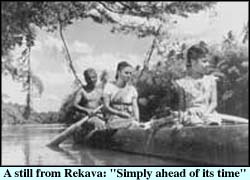 Debut
films often have special significance for directors, and there is little
doubt that Lester must look back on Rekava with great affection.
Just as Satyajit Ray had gained international recognition with the screening
of his first film, Pather Panchali, at the 1956 Cannes Film Festival,
so too did Lester when Rekava was unveiled at the same festival
just one year later. Paradoxically, though, local audiences largely spurned
the film. It was simply ahead of its time.
Debut
films often have special significance for directors, and there is little
doubt that Lester must look back on Rekava with great affection.
Just as Satyajit Ray had gained international recognition with the screening
of his first film, Pather Panchali, at the 1956 Cannes Film Festival,
so too did Lester when Rekava was unveiled at the same festival
just one year later. Paradoxically, though, local audiences largely spurned
the film. It was simply ahead of its time.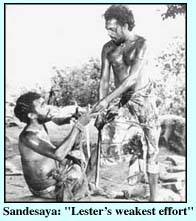 I
have always had an interest in Sandesaya because among Lester's
films it is the closest to being a precursor to The God King. True,
it is one of Lester's weakest efforts. It is overly theatrical and badly
acted. Yet it displays both Lester's and Willie Blake's developing mastery
of the medium. Even though it is many years since I last viewed Sandesaya,
I remember vividly some of Willie's dramatic low angle shots of figures
on a rocky outcrop, silhouetted against the sky.
I
have always had an interest in Sandesaya because among Lester's
films it is the closest to being a precursor to The God King. True,
it is one of Lester's weakest efforts. It is overly theatrical and badly
acted. Yet it displays both Lester's and Willie Blake's developing mastery
of the medium. Even though it is many years since I last viewed Sandesaya,
I remember vividly some of Willie's dramatic low angle shots of figures
on a rocky outcrop, silhouetted against the sky.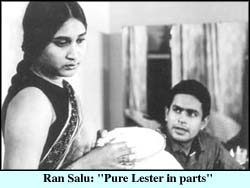 It
is my conviction that Ran Salu has a special appeal for foreign
audiences, which is why it was so well received at the Cork and Edinburgh
film festivals. Overseas viewers, including myself, find this delicate
story particularly endearing, and appreciate the minimal dialogue and classic,
unadorned style in which Lester directs it.
It
is my conviction that Ran Salu has a special appeal for foreign
audiences, which is why it was so well received at the Cork and Edinburgh
film festivals. Overseas viewers, including myself, find this delicate
story particularly endearing, and appreciate the minimal dialogue and classic,
unadorned style in which Lester directs it.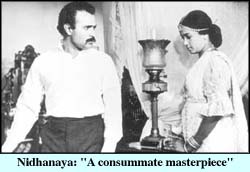 This
consummate masterpiece was the first of Lester's films that I had the privilege
of seeing. For a young, Western film student, I suppose Nidhanaya was an
ideal introduction to his work. With its powerful story of a man obsessed
by treasure, this intriguing movie has me totally absorbed during the London
Film Festival screening I attended that cold winter's night . As I shivered
my way home thinking about Nidhanaya and the exotic country in which it
had been filmed, never in my wildest dreams could I have imagined that
in a few months time I would be working for Lester in the warmth of Sri
Lanka.
This
consummate masterpiece was the first of Lester's films that I had the privilege
of seeing. For a young, Western film student, I suppose Nidhanaya was an
ideal introduction to his work. With its powerful story of a man obsessed
by treasure, this intriguing movie has me totally absorbed during the London
Film Festival screening I attended that cold winter's night . As I shivered
my way home thinking about Nidhanaya and the exotic country in which it
had been filmed, never in my wildest dreams could I have imagined that
in a few months time I would be working for Lester in the warmth of Sri
Lanka.